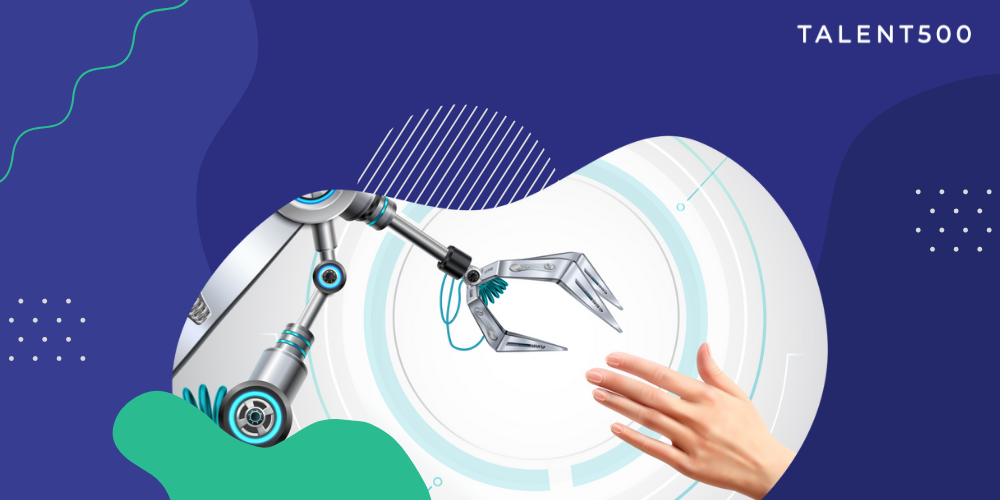As we continue to innovate and find new ways to leverage technology, displacement of some kind is inevitable. On the subject of workplace automation, which has been trending for a few years now, the opinions of the masses and experts are divided. Some believe that the fourth industrial revolution will take away jobs, and it will, but there is data to suggest that not everything is as bleak as it might seem. Reports like the Future of Jobs published by the World Economic Forum state that while around 75 million jobs will be displaced, around 133 million new jobs will emerge as well.
So, what does this mean for the future displaced workforce? Simply put, it reiterates the need for reskilling or upskilling to best align with the changing times. Corporations and enterprises must take the lead here as machines will soon take over menial and administrative tasks. In 2018, machines did 29% of the work, and this number is slated to rise to 52% by 2025.
A McKinsey report published in 2021 corroborates this and goes on to state that 1 in 16 employees will need to find a new job by 2030. This is where a workforce proficient at non-routine analytical tasks, technical familiarity, and critical thinking will need to take the reins.
Preparing now seems to be the best way to get ahead of the revolution brought on by accelerated technology adoption. While 31% of organizations are worried about displacement within their workforce, and rightly so, be a part of the remainder that has done the needful to brave it while minimizing losses. To know how to do just that and build a workforce for the future, consider the following strategies.
Assess and conquer
Before putting in any money or effort into initiatives, it is important to form a baseline. Companies should take the time to figure out the digital literacy levels across all employees. These skills vary with employees and not all responsibilities require as much digital literacy as others. This is where assessment comes in handy, and it helps companies determine what they are willing to accept as a bare minimum going forward.
Once the early assessment stages are clear, conquering the shortcomings can begin. The road to creating a workforce that can align with the new division of labor is one built through a systematic approach. Without a baseline, it is possible that significant resources may go to waste. During the assessment stages, companies must also determine whether the goal is to upskill or reskill. These vary greatly from each other and are in no way synonymous as many may believe.
In order to reposition effectively, companies can either:
- Upskill employees to be better at their existing jobs by advancing their practical knowledge to accommodate newer technologies or practices.
- Reskill employees to develop newer, more relevant skills that will help them take on a new position within the organization.
Develop or borrow from an efficient digital training framework
To build a truly resilient workforce equipped to brave the storms brought on by the fourth industrial revolution, a proper training framework must be in place. These should categorize skills that are essential for work and those that are simply good to have. Based on existing models already in use across industries, here are a few skills that should be assessed and primed for development through such frameworks.
- Basic digital tools
- Occupation-specific tools
- Data ethics
- Problem-solving using technology
- Data safety and security
- Digital devices and their interactions
- Data manipulation
- Data analytics
A combination of these categories should form the roadmap as they target core areas for holistic development, be it reskilling or upskilling.
Invest in training and continuous learning across the board
Companies looking to uplift their workforce through training and learning must utilize all avenues available for it. Interactive experiences are now not only possible but so much more engaging than training programs of the past. Today, companies have options such as:
- Online training courses
- Certificate courses
- Mobile learning
- Personalized learning solutions
Each has its own merits and these can serve as incentives to better integrate learning and self-growth into the company culture. Remember, for any company, the goal should be to autotomize the learning experience, without making it a mandate that gets done because it has to. Digital experiences, especially from leading L&D companies, add value to both employee and company. As such, investing in the best is likely to deliver desired results that could very well lead to the success of the program.
Institute a mentorship program
The mentor-mentee relationship is one that has immense potential. Here, companies can either have an in-house program that drives growth and culture or opt to outsource for their mentorship needs. In either way, employees get hands-on training and learn to be practical. Mentors are a trove of knowledge and for many new to the digital landscape, a mentor’s experience could be the difference between a healthy transition and one brought on through need alone.
Digitize the experience
Much like other experiences employees enjoy today, where convenience is a given, training for industry 4.0 should offer no less. Building familiarity is much easier this way, and showcases the true potential of modern technology. What’s more, digitized learning can make people-led solutions a lot more feasible. Where online courses and seminars lack, personalized portals and digital labs excel – offering customizability and potential for hands-on innovation.
Developing a digital learning lab also benefits the company as it can be tuned to gather insights. By understanding how employees learn, what modes work best, and which formats are the go-to, enterprises can spend their training dollars in a more effective and meaningful way.
Whether the objective is to reskill or upskill, remember that either of the options is only a means to best utilize the company’s resources. It is not a substitute for hiring but can make the undertaking a lot more cost-effective. For many companies, hiring will continue to be a business-critical process. Technology companies could feature among these as they stand to benefit from a technically-proficient workforce. With remote working slowly becoming the standard, finding talent that suits the budget and can align with company objectives is easy, especially if you partner with Talent500.
With access to over 200,000 pre-vetted professionals, harnessing the power of global teams is within reach. Our AI-powered tools promise a smooth hiring experience, for both ends, and can serve as an efficient solution for scaling goals. Schedule a consultation today and be part of the global remote revolution that’s leveraging talent in the best way possible.






Add comment